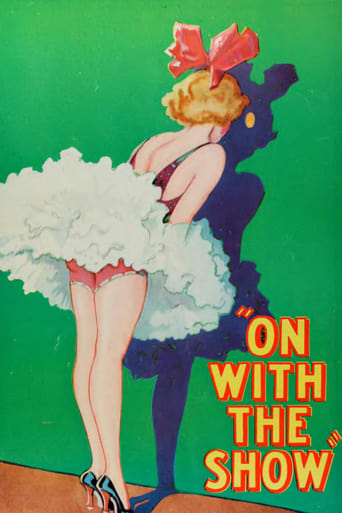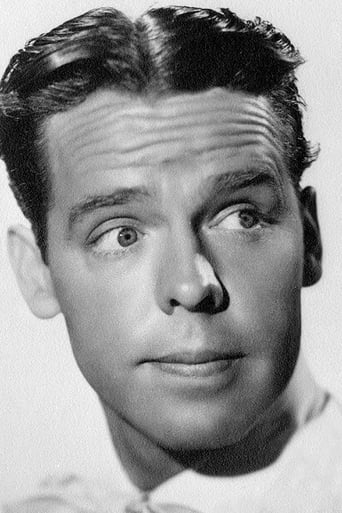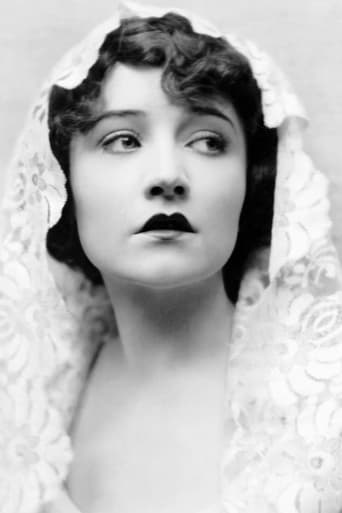

On With the Show! (1929)
With unpaid actors and staff, the stage show Phantom Sweetheart seems doomed. To complicate matters, the box office takings have been robbed and the leading lady refuses to appear. Can the show be saved?
Watch Trailer
Cast


Reviews
To me, this movie is perfection.
Absolutely the worst movie.
Pretty good movie overall. First half was nothing special but it got better as it went along.
The film's masterful storytelling did its job. The message was clear. No need to overdo.
I'm glad that I've been given the gift of seeing old movies as a product of their time, otherwise I would not be able to get through "The Broadway Melody", "Hollywood Revue", "The Show of Shows", "Rio Rita" or the several dozen other ancient early movie musicals, all released in 1929. This smash hit is the extreme example of why they were so popular in the days before and after the market crash, as they were thoroughly modern and filled with the biggest song hits of the day. Like many others, this is a backstage story, telling the believable tale of what goes on in a Pre-Broadway tryout. The show backstage is more dramatic than the goings on in front of the audience. The leading diva (Betty Compson) has demands that can't be met, and the producer bemoans the lack of funds. As the show goes on, a dramatic robbery occurs, making the situation all the more dire.Best known for two memorable numbers featuring the legendary Ethel Waters (including her big hit "Am I Blue?"), this also has the rubber legged Joe E. Brown provides the laughs in front of the stage, but he's a pill to deal with backstage. Louise Fazenda, in a fright wig, gets the wisecracks, and the future Dagwood Bumpstead (Arthur Lake) gets falsely accused of the robbery. The dramatic scenes are short and sweet, often interjected during the musical numbers. The show itself seems to be a homage to the recent Broadway smash "Show Boat". Only infrequently static, this is practically perfect in every way. I would have loved some dramatic moments with Waters, truly moving in her brief time on screen. I have the feeling that her scenes could easily be cut for showings in the South, but for me, her involvement in this is as important as the principals. After all, her real life was all about going on with the show, keeping those tears hidden.
This one will probably be of interest only to fans of the early talkies. Because it is made so early in the talking picture era, it suffers from dialogue overload, which results in an over-long run time of 103 minutes that could have easily shed 30 minutes without anyone objecting or even noticing. The main thing that harms this film is that it was originally shot completely in two-strip Technicolor, but only the black and white prints made for television remain. As a result you have lots of chorus girls parading around in elaborate gowns, pausing for the audience to get an eyeful, and then moving on. In black and white these scenes are just dull and stagnant, but if you've ever seen the same thing in the remaining color reels of "Gold Diggers of Broadway" from the same year, you realize how truly spectacular this must have looked to 1929 audiences. Also, Alan Crosland's sharp visual style includes lots of cross-cutting so that you don't have the claustrophobic static effect that you normally get from Vitaphoned films whose camera booths could not move an inch.It is a show within a show, the film being the story of one make-or-break night in the life of "The Phantom Sweetheart" and its cast, as it lumbers towards Broadway. You get to see "The Phantom Sweetheart" play out in its long-winded entirety, which actually contains the high-points of the film. These include two numbers by Ethel Waters as herself performing "Birmingham Bertha" and "Am I Blue" as well as the eccentric dancing and acrobatics of Joe E. Brown. Ms. Waters has no dialogue in the film, and for that matter her excellent numbers have absolutely nothing to do with the plot of "The Phantom Sweetheart", which is an inane tale of a young man who comes home from a long trip to marry his girl, but falls for a mysterious nymph of the woods and has to decide whether to go with this surreal and beckoning creature, or stay with the girl to whom he is betrothed. Harold (Arthur Lake), the double-minded young star of the Phantom Sweetheart, is as annoying and whiny on stage as he is backstage.Backstage, the center of attention is Kitty (Sally O'Neill), an usher with the show who is in love with the other usher and whose father has invested everything he has in the world with the show. Betty Compson, the most overworked actress of 1929, is the "phantom sweetheart" and star of the show who threatens not to go on if she isn't paid her back wages. This film is full of performers who are either the victims of the transition to sound or the product of failed Warner Brothers experiments with stage performers. Thus, you'll likely not recognize 80% of the cast. For example, Sally O'Neill had been making a good career in films in the late silent era. Unfortunately, in reality she was saddled with a heavy New Jersey accent that is compensated for in this film by making her overly-sweet. A little bit of cute sweetness would be a good thing, but since she is basically the female lead here, I was ready to shoot an arrow through her forehead at the film's half-way point just to put an end to her bubbly babble.So watch it for the wonderful Ethel Waters as herself, for Joe E. Brown and his well delivered smart comments and acrobatics, and for the infancy of the urban working-class banter that will become Warner Brothers stock and trade during the early 30's.
On With the Show! (1929) * 1/2 (out of 4)This early sound film from Warner was actually the first full sound musical to be show in color but sadly the color version (2-strip Technicolor) is now lost. What remains is the B&W version, although recently one-minute worth of color footage was found. This film is clearly Warner's reply to MGM's THE Broadway MELODY as we get all the backstage drama of a show currently going on. We'll see a musical act or comic team and then we see what's going on backstage. This routine carries from start to finish as we get involved with various stories ranging from a boy needing to send money to his sick mother to an actor trying to steal scenes from another. Fans of history in terms of movies will probably want to check this out but all others should stay clear as it hasn't aged too well (and I'm not sure it would have been considered good in 1929). The movie is very dated in terms of production and being an early talkie we also have to put up with some pretty bad audio. I'm not sure if the color version would have helped things but I'm going to guess it would have at least given us some pretty things to look at. I've never been a fan of Crosland's and that includes his most popular film THE JAZZ SINGER. His direction here is a lot more upbeat as he at least keeps the camera moving and doesn't just settle on one set up and shot. Betty Compson is good in her role and a somewhat laid back Joe E. Brown is as well. The majority of the acting is pretty bad here but the dance and music numbers usually make up for it. It's also worth noting that the black actors in the film are played by blacks and not just whites in blackface. Another thing that does keep the film moving are some nice pre-code images from backstage with the women undressing and walking around in skimpy outfits. With that said, there's not enough here to warrant a 102-minute running time and by the half way part you'll be squirming in your chair making this a rather hard film to sit through.
When I saw "On With the Show" on Turner Classic Movies, I was very disappointed in the poor quality of the picture and the sound, but was very pleased by some clever dialog, although realizing some of it was not so clever, and I was absolutely in awe of the performance of Betty Compson.She was not only lovely just to look at, in her big scene near the end, she stole the show.She was more than charming -- she was adorable.Joe E. Brown's presence in a movie is usually enough to make me skip it but here he is toned down considerably, is not so silly, and he performs an eccentric dance with a surprising athleticism. I actually liked him in "On With the Show." Sally O'Neil was surprising. She sounded at first like some precocious child, with little-girlish voice, but when this caterpillar bursts out of her cocoon, she is a star.One other aspect of this film is almost unique for its time: The cast is integrated. Right there on stage are black dancers with white dancers, although to be accurate there is not interaction between white and black. Still, it was a start.Ethel Waters made what was apparently her film debut, and surely was an immediate hit since she was already a star in other media.A 21st century viewer of "On With the Show" must consider context, remember the times in which it was made, during the changeover from silents to talkies, to be able to appreciate it fully.There were lots of great individual talents involved, and a viewer should try to ignore the poor framing of the scenes and the poor quality of the sound, at least some of which might be because of the age or even generation of the print.But appreciate the historicity as well as the talent, and you will enjoy "On With the Show" as much as I did.




